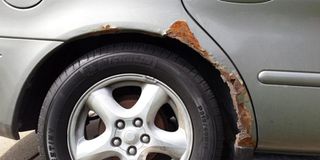Protecting your car from rust

Many times, road salt and other contaminants encourage corrosion in our cars. This means that dirty or salty water trapped somewhere in our car’s body makes that spot rust faster. Photo/ internet
What you need to know:
The most common cause of rust is too much moisture resulting from continued exposure to rain or snow. Cars can also get rusty due to old age or not being properly covered. Here are some tips on protecting your car from rust.
Every motorist wishes to see their car new and shiny. However, over time, its body may start to rust.
According to Bob Musinguzi, a washing bay attendant and mechanic, rusting mostly starts from the sides or from the bottom just below the door edges and works its way upwards. It may sometimes be hard to notice until a bigger portion of the car body has rusted away.
“Car bodies are manufactured with high quality paint that can still look beautiful and intact on top yet the internal side is slowly rusting. It manifests with bubble-like swellings on top of the car paint,” Musinguzi explains.
Besides the car body, other car parts that are susceptible to rusting include the exhaust pipe or the exhaust system, fuel tank and brake discs, among others. Sometimes it is the floor of the car. These and many others are found underneath the car and preventing them from rusting is something manageable if noticed early.
Drying your car
For instance, by the time your car floor rusts, it means water may have found its way to the car floor. If you did not drive through floods, the washing bay attendant may not have dried the car thoroughly or left all the car doors open for the interior to dry well and just put back the car carpets.
“If the car floor mat is not given time to dry, it means the water that was retained in the floor carpet will make the metallic car floor moist leading to rusting overtime,” Musinguzi explains.
Where you park
Besides your home compound, you will sometimes resort to parking your car in an area that is bushy. It may be for a short while or for a long time. The disadvantage of parking in an unkempt compound, according to Sam Kivuna, a motorist, is that the water from the grass gains contact with the car body, especially underneath and over time, starts to rust. “If you park in the compound, have a smaller section paved to accommodate your car,” Kivuna advises.
Wash your car well
Washing your car stretches just beyond the interior and the car body to underneath the car.
James Bright, a motorist, observes that while driving, mud and dirt stick to the bottom of the car. Some of it may coat and dry on these parts because of heat generated by the car and other dirt will remain wet. Bright explains that if you do not have the underneath of your car washed to remove the mud, it will eventually attract moisture and cause gradual rusting.
Musinguzi adds that after thoroughly washing your car, go an extra mile and have its body polished. This prevents it from rusting, given the fact that the older your car becomes, the more its initial body paint becomes weaker and gives in to rusting after continuous exposure to moisture, especially if you park it in the open.
Use anti-spray
Motorbiscuit, an online portal, advises that if you see a little rust accumulating on your car, the best thing do to is to treat it before it spreads. If caught in time, the portal advises that you will not have to take your car to the shop or replace the rusted part. Any area where the paint is bubbling is usually a sign of rust.
“First, clean the area and let it air dry. Once the area is free of any moisture, you can apply anti-rust spray. This is a good alternative if you cannot afford regular waxing or ceramic coating. Once applied, the spray can protect your car for up to one year,” the portal says.
Clean your drains
Bestride.com notes that every single car has drains in various locations. They are designed to keep water from collecting in places that are prone to rust. When drain holes get plugged with leaves, dirt and pine needles, they do exactly the opposite of the job they are supposed to do, to the point that you will start to hear water sloshing around inside of doors and fenders.
“You will have to find the drains in your specific car, but they are usually along the bottom of the doors, in the floors, at the bottoms of fenders, and in the tailgate. Pay attention to the drains in your sunroof, too. They are usually at the forward corners,” the portal advises.
Tip
Keep drain plugs clear. Drain plugs are often overlooked when caring for your car, but checking them can help prevent rust. These plugs can become clogged with debris, which will allow water to accumulate. When you wash your car, remember to check drain plugs and clean them out if needed. You can find these under your car doors and along the edges of the trunk and hood.




